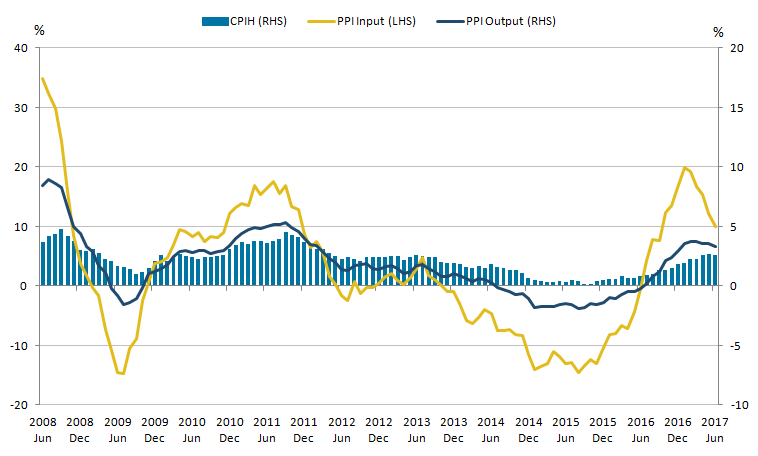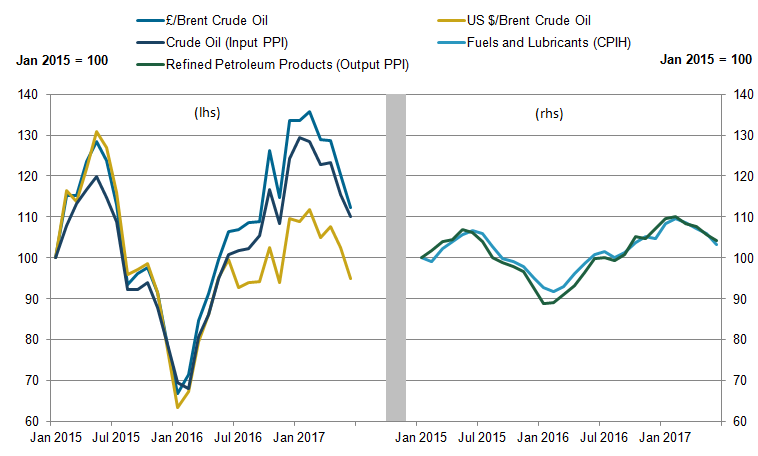Cynnwys
1. Main points
- The Consumer Prices Index including owner occupiers’ housing costs (CPIH) fell slightly to 2.6% in the 12 months to June 2017, while the growth rate of the price of goods leaving the factory gate also fell, to 3.3%.
- World prices for brent crude oil have been falling since January 2017, feeding through to falls in producer and consumer prices for crude oil, refined petroleum products and fuels and lubricants.
- Consumer prices for goods, including food, have been on an upward trend since mid-2016 in the UK and the EU as a whole.
- Slower house price growth in London and the southern regions of the UK is narrowing the regional house price divide.
2. Statistician’s comment
Commenting on today’s consumer, factory gate and house price figures, ONS Deputy National Statistician Jonathan Athow said:
“Today’s fall in inflation is mainly due to drops in petrol and diesel prices. However, the rate remains higher than in the recent past.
“Petroleum products were mainly behind the drop in the annual growth rate of factory gate prices. Likewise, crude oil was mainly responsible for the recent slowing of input price inflation, with both its dollar price down and some recovery in sterling.
“Meanwhile house prices continue to go up, but the rate of increase has slowed since mid-2016. London saw the second-slowest annual growth of any part of the UK.”
Nôl i'r tabl cynnwys3. Summary
Figure 1 shows that the input Producer Prices Index (input PPI) grew by 9.9% in the 12 months to June 2017, down from 12.1% in the 12 months to May 2017. The output Producer Prices Index (output PPI) grew by 3.3% in the 12 months to June 2017, down from 3.6% in the 12 months to May 2017.
Figure 1 also shows the 12-month growth in the Consumer Prices Index including owner occupiers’ housing costs (CPIH) was 2.6% in June 2017. More information about consumer prices and how they have changed since 2005, including visual representations of changes to individual components of CPIH, are available.
Figure 1: Annual growth rate for PPI input (left-hand side), PPI output and CPIH (right-hand side)
June 2008 to June 2017, UK

Source: Office for National Statistics
Notes:
- These data are also available within the Dashboard: Understanding the UK economy.
Download this image Figure 1: Annual growth rate for PPI input (left-hand side), PPI output and CPIH (right-hand side)
.png (24.4 kB) .xls (34.3 kB)4. Falling world oil prices in the first half of 2017 have contributed to slower price growth
World prices for brent crude oil as well as producer and consumer prices are shown in Figure 2. The left-hand panel shows world prices for brent crude oil, in both pounds sterling and US dollars, and the prices that manufacturing firms pay for crude oil as represented by the crude oil component of the input Producer Prices Index (input PPI). The right-hand panel shows consumer prices for fuels and lubricants from the Consumer Prices Index including owner occupiers’ housing costs (CPIH) and factory gate prices for refined petroleum products from the output Producer Prices Index (output PPI).
As seen in Figure 2, the brent crude oil prices in pounds sterling and US dollars tracked each other closely between January and December 2015 but started to diverge at the beginning of 2016. This gap widened further from June 2016 as pounds sterling depreciated following the EU referendum. This gap has remained although the stabilisation and slight appreciation of pounds sterling since the beginning of 2017 has meant that the pounds sterling and dollar prices have followed more similar trends in recent months. Recent falls in the crude oil component of input PPI are reflective of falls in world prices for brent crude oil in both pounds sterling and US dollars.
Figure 2: Brent crude oil and crude oil (input PPI) index (left-hand side), and refined petroleum products (output PPI) and fuels and lubricants (CPIH) index (right-hand side)
January 2015 to June 2017, UK

Source: Office for National Statistics, Bank of England, Financial Times
Download this image Figure 2: Brent crude oil and crude oil (input PPI) index (left-hand side), and refined petroleum products (output PPI) and fuels and lubricants (CPIH) index (right-hand side)
.png (35.0 kB) .xls (42.0 kB)As shown on the right-hand panel, both the fuels and lubricants component of CPIH and the refined petroleum products component of output PPI have tracked each other closely over the period. Declines in the fuels and lubricants component of CPIH since the beginning of 2017 are reflective of the changes seen on the producer side, with falling prices for crude oil.
Nôl i'r tabl cynnwys5. Prices for goods, including food, have been increasing in Europe and the UK
Figure 3 shows the aggregate goods component of the Harmonised Index of Consumer Prices (HICP) for the UK, Germany, France and the whole EU, indexed to January 2014. The HICP is equivalent to the Consumer Prices Index (CPI) in the UK and allows for international comparisons to be made on a consistent basis.
Trends for consumer prices in goods have been comparable for all three countries and the EU as a whole since January 2014. They all experienced periods of deflation in goods prices up to mid to end 2016. However, in the UK the price of goods fell relatively faster compared with the whole of the EU, France and Germany, resulting in a much greater change in prices over the period since January 2014. By July 2016, the price of goods in the UK was negative 3.5% lower than January 2014. However, since March 2017, the 12-month growth rate for goods in the UK has been higher than that of the other countries.
Figure 3: Harmonised Index of Consumer Prices for all goods for the EU, Germany, France and the UK
January 2014 to June 2017
Source: Eurostat
Notes:
- Data are not available for June 2017 for France, the EU or Germany.
Download this chart Figure 3: Harmonised Index of Consumer Prices for all goods for the EU, Germany, France and the UK
Image .csv .xlsThe weakness in UK goods price inflation over the period February 2015 to February 2017 may be partly due to the behaviour of food prices in the UK over this period. In 2016, food and non-alcoholic beverages accounted for around 20% of the total goods basket in the UK CPI. Figure 4 shows the HICP for food and non-alcoholic beverages for the UK, France, Germany and the EU, indexed to January 2014.
Figure 4: Harmonised Index of Consumer Prices for food and non-alcoholic beverages for the EU, Germany, France and the UK
January 2014 to June 2017
Source: Eurostat
Notes:
- Data are not available for June 2017 for France, the EU or Germany.
Download this chart Figure 4: Harmonised Index of Consumer Prices for food and non-alcoholic beverages for the EU, Germany, France and the UK
Image .csv .xlsWhile food prices in Europe have been growing fairly steadily, the UK has seen food price deflation over much of the period and prices remain below the January 2014 level. This has been linked to supermarket price wars, which resulted in downwards pressure on food prices. However, all countries are now seeing an increase in food prices as a result of the upward trend in global food prices.
Analysis of the UK experience of global commodity prices including food is available in the Economic Review July 2017.
Nôl i'r tabl cynnwys6. North-south house price divide is narrowing due to slow growth in the southern regions
Looking at 12-month growth in regional house prices, Figure 5 shows falls in annual price growth for most regions when comparing the year to May 2016 and the year to May 2017. The largest falls in annual price growth were seen in the southern regions of the UK. The East of England, the South East and London have all fallen by 5.0 percentage points, 6.3 percentage points and 9.4 percentage points respectively.
Figure 5: Annual house price growth, by region
May 2016 and May 2017, UK
Source: UK House Price Index, Office for National Statistics
Download this chart Figure 5: Annual house price growth, by region
Image .csv .xlsIn the year to May 2017, the difference between the highest growing region (East of England) and the lowest growing region (North East) is 5.9 percentage points. This regional gap is below the long run average of 9.6 percentage points (January 2005 to May 2017). The last time that the difference in the annual growth rate between the highest and lowest regions was lower than 5.9 percentage points was in March 2012.
While the southern regions of the UK may have started to experience slower annual growth in recent months, there is still a large north-south divide in terms of average price levels. The average house price in the North East in May 2017 was £127,000 compared with £481,000 in London, which is 3.8 times higher.
Nôl i'r tabl cynnwys